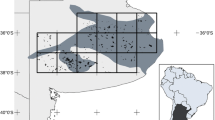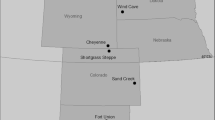Abstract
Eighteen years of herbage yields of range grasses and concomitant precipitation and temperature fluctuations were examined with correlation and regression techniques. Antecedent precipitation was the dominant factor influencing yield of perennial herbaceous species, while both temperature and precipitation were important for prediction of yield of downy bromegrass, a winter annual. Total yield of the herbaceous community was closely correlated with precipitation received during the September to June period (r = 0.92); however, September to March precipitation was also highly correlated (r = 0.89). These correlations provide timely and useful estimates of native range production on eastern Oregon ranges. Sixty to 92% of yield variation was accounted for by the regression models for 9 of the 12 species or species groups examined.
Similar content being viewed by others
Literature cited
BlAISDELL, J. P. 1958. Seasonal development and yield to native plants on the upper Snake River plains and their relation to certain climatic factors. U.S. Dept. Agric. Bull. 1190.
Climatological Data for Oregon. National Oceanic and Atmospheric Administration, Environmental Data Service. National Climatic Center, Asheville, N.C.
ECKERT, R. E., Jr. 1957. Vegetation-soil relationships in someArtemisia types in Northern Harney and Lake counties, Oregon. Ph.D. Thesis. Oregon State Univ., Corvallis. 208 p.
HYDER, D. N. 1961. Growth characteristics of crested wheatgrass in the big sage-brush-bluebunch wheatgrass province of southeastern Oregon. Ph.D. Thesis. Oregon State Univ., Corvallis.
HYDER, D. N. and F. A. SNEVA. 1956. Herbage response to sagebrush spraying. J. Range Manage. 9(1): 34–38.
KELLER, W. 1959. Breeding improved forage plants for western ranges. Grasslands. 334–344 p.
PINGREY, H. B. and E. J. DORTIGNAC. 1959. Economic evaluation of seeding crested wheatgrass on Northern New Mexico rangeland. New Mexico State Univ. Ag. Exp. Sta. Bull. 433.
REYNOLDS, H. G. and H. W. SPRINGFIELD. 1953. Reseeding southwestern rangelands with crested wheatgrass. U.S. Dept. Agric. Farmers' Bull. 2056.
SAMPSON, ARTHUR W. 1952.In, Range Management Principles andPractices. John Wiley & Sons, Inc., N.Y.
SCHREVEN, D. A. VAN. 1967. The effect of intermittent drying and wetting of a calcareous soil and carbon and nitrogen mineralization. Plant and Soil 16:14–32.
SNEVA, FORREST A. 1977. Correlations of precipitation and temperature with spring, regrowth, and mature crested wheatgrass yield. J. Range Manage. 30:270–275.
SNEVA, FORREST A. 1979. Temperature-precipitation considerations in eastern Oregon. Oregon State Agric. Exp. Sta. Spec. Rept. 537.
SNEVA, FORREST A. and D. N. Hyder. 1962. Estimating herbage production on semi arid ranges in the intermountain region. J. Range Manage. 15(2): 88–93.
Author information
Authors and Affiliations
Rights and permissions
About this article
Cite this article
Sneva, F.A. Relation of precipitation and temperature with yield of herbaceous plants in eastern Oregon. Int J Biometeorol 26, 263–276 (1982). https://doi.org/10.1007/BF02219493
Issue Date:
DOI: https://doi.org/10.1007/BF02219493




